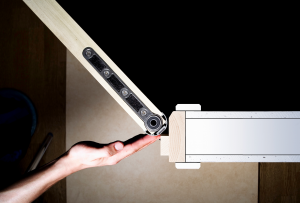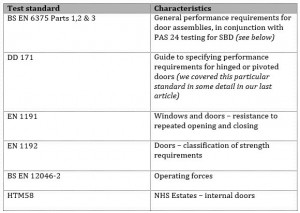An introduction to security doors
Article Updated 22/08/2018
When sourcing internal doors for any industrial or domestic project we’re sure security will be high on your list of requirements. Below we’ve put together an overview of both why rated security doors are a good idea and their characteristics.
The need for a security door
It probably seems obvious, but just to be on the safe side let’s cover off why we might need a security door:
- One main reason, as the name implies, is to prevent unwanted access. This could be an external door, thus preventing people from entering unless they have authorisation, or an internal door, for example into a secure area or office. Be mindful though, as we’ve pointed out before, that however secure the door needs to be it must allow the quick and easy passage of people in an emergency
- To prevent (or at least slow down) the passage of fire and / or smoke, giving people time to evacuate.
- There’s another reason too, easy to overlook but definitely worth considering, and that’s the safety angle. Have you ever caught your fingers in a closing door? “Ouch” springs to mind, but some serious injuries can occur in this way, so the type of hinge is important – one that removes the gap is of course ideal!
- Let’s also mention durability – the longer the doors last, the more secure your installation is… and let’s not forget security from increasing costs of having to replace them!
So let’s look into one of these areas in detail in our first article in this sequence.
Avoiding the “ouch” … or a more serious injury
We mentioned above the desire to design the hinge in such a way that there is no gap for fingers to get caught in. The good news is that there is such a mechanism, known as Safehinge, which achieves complete finger safety as it allows the door to pivot without creating a gap.
Here’s an image that demonstrates this:

As you can see, this type of door hinge completely eliminates any chance of fingers getting trapped by using a specialist pivot set and a curved (aluminium) profile – the gap at the hinge when opening and closing is therefore eliminated.
What is Safehinge?
This type of door hinge completely eliminates any chance of fingers getting trapped by using a specialist pivot set and a curved (aluminium) profile – the gap at the hinge when opening and closing is therefore eliminated.
It’s one thing – and a very important thing of course – to eliminate the chances of hands and fingers getting trapped in doors. For an infrequently used door, perhaps in an office environment, this may be adequate. But what if the door is in a public building and/or is used frequently and perhaps not terribly gently – such as a school door? In such situations there is a British Standard which provides guidelines on what is and isn’t acceptable.
The British Standard Draft for Development DD171:1987 “Guide to specifying performance requirements for hinged or pivoted doors”
The standard specifies that a door in a commercial or public building must continue to operate satisfactorily for long periods of time even under conditions of extreme or “violent” usage, and even when it is not regularly maintained. There are four levels or “classes” as follows:
Light Duty
Low frequency of use by those with a high incentive to exercise care, for example by private house owners. Typically there is quite a small chance of an accident occurring, or of misuse. This would apply both to internal and external doors.
Medium Duty
A notch up from Light Duty – here there is a medium frequency of use by those with some incentive to exercise care; there is some chance of an accident occurring, or of misuse. This would apply to office doors providing access to designated public areas but which are not used by the public.
Heavy Duty
For these doors there is a high frequency of use by the public and others with little or no incentive to exercise care. As a consequence there is a reasonable probability of an accident occurring and of misuse. This level would apply to doors which are installed for example in retail and commercial properties, as well as some health and education buildings, and which provide access to designated public areas and which are used by the general public.
Severe Duty
This is the highest level. Such doors are subject to frequent and “violent” usage. Imagine doors installed in stockrooms, which are commonly opened simply by pushing trolleys against them, or doors in Accident and Emergency Units in hospitals. And, of course, school doors!
Security Door test standards and characteristics
These tests are used to evaluate the following:
- the operating forces (i.e. how much effort is required to operate the windows and doors)
- the repeated opening and closing of doors and windows through cyclic testing; note that Safehinge has undergone cyclic testing to over 1.5 million cycles without any sign of failure. This reliability is down to the quality of materials that they are made from – 316 Stainless Steel and anodised aluminium – and the excellence of their design
- “abuse” in operation
PAS 24
Pas 24 is an enhanced security performance requirements for doorsets and windows in the UK. External doorsets and windows intended to offer a level of security suitable for dwellings and other buildings exposed to comparable risk. Testing includes:
- manual manipulation
- manual infill medium removal
- mechanical infill medium removal
- mechanical loading
- manual check
- soft body impact
- hard body impact
- manual cutting
- hardware and cylinder security
SBD
Stands for “Secured by Design” and means that the security doors (and windows) meet high security standards as accepted by the Police. They are tested by replicating the forces that would be applied by an intruder, and in addition to the above focus on general performance including:
- operating forces
- air permeability
- water-tightness
- wind resistance
- basic security
- cyclic operation
- operational strength characteristics
The BSI site gives further details, which you may find interesting if you want to explore the topic further.
Speak to the experts …
If you would like some further information on security doors, give us a call on 020 3199 5840.
And as always we’ll be delighted to help you and pass on our expertise.









